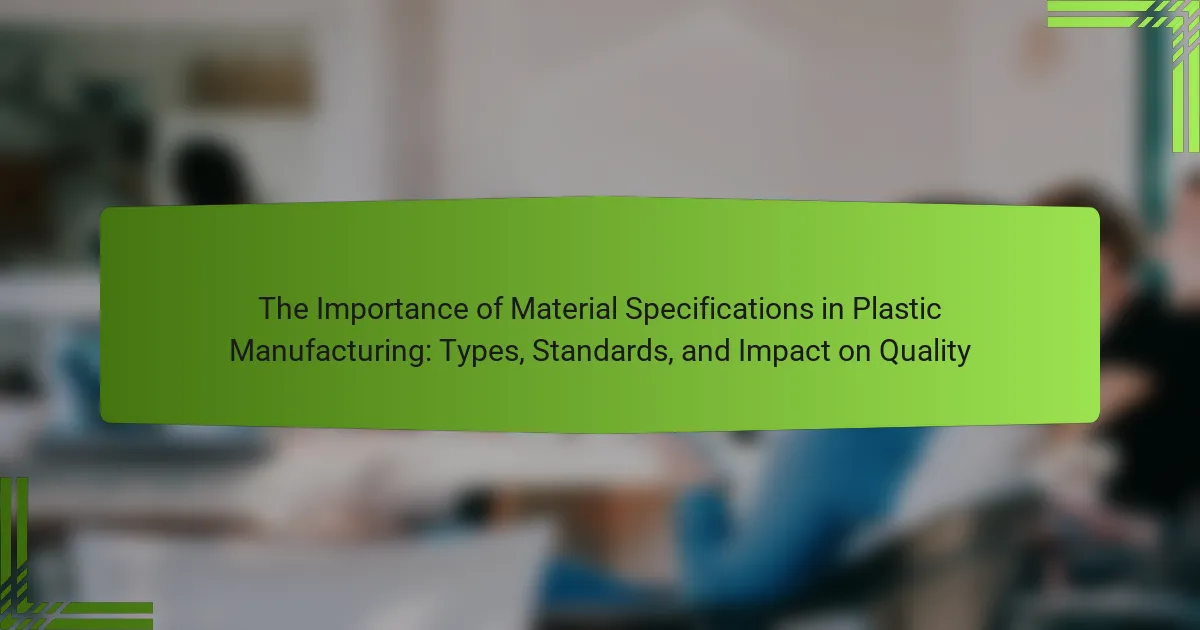Material specifications in plastic manufacturing are essential guidelines that define the required physical, chemical, and mechanical properties of plastic materials. These specifications ensure compliance with industry standards, such as ASTM, ISO, and ANSI, which govern the quality and performance of plastic products. Key aspects of these specifications include tensile strength, impact resistance, and thermal stability, all of which are crucial for product durability and safety. Adherence to these standards not only enhances product reliability but also mitigates the risk of failures and warranty claims, underscoring the importance of precise material specifications in maintaining quality control and optimizing production efficiency.

What are Material Specifications in Plastic Manufacturing?
Material specifications in plastic manufacturing define the required characteristics of plastic materials. These specifications include physical, chemical, and mechanical properties. They ensure that materials meet industry standards and performance requirements. Common specifications cover aspects like tensile strength, impact resistance, and thermal stability. Compliance with these specifications is critical for product durability and safety. For example, the ASTM D638 standard outlines tensile properties for plastics. Adhering to such standards helps manufacturers produce reliable and high-quality products.
Why are Material Specifications Crucial in Plastic Manufacturing?
Material specifications are crucial in plastic manufacturing because they ensure product quality and performance. They define the physical and chemical properties of materials used. Accurate specifications help in selecting the right type of plastic for specific applications. This minimizes defects and enhances durability. Without clear material specifications, manufacturers risk producing substandard products. This can lead to increased costs and customer dissatisfaction. Industry standards, such as ASTM and ISO, provide guidelines for material specifications. Adhering to these standards ensures consistency and reliability in production.
How do Material Specifications Influence Product Quality?
Material specifications directly influence product quality by dictating the properties and performance of materials used in manufacturing. Specific attributes such as tensile strength, flexibility, and thermal resistance are defined by these specifications. When materials meet or exceed these specifications, the resulting products demonstrate enhanced durability and functionality. Conversely, substandard materials can lead to product failures and increased defect rates. For instance, using high-grade polymers can improve resistance to environmental factors, thus extending product lifespan. Research shows that adherence to material specifications can reduce production costs by minimizing waste and rework. Therefore, precise material specifications are essential for ensuring consistent product quality in plastic manufacturing.
What Role do Material Specifications Play in Regulatory Compliance?
Material specifications are critical for ensuring regulatory compliance in plastic manufacturing. They define the required characteristics and performance of materials used in products. Compliance with these specifications helps manufacturers meet safety, environmental, and quality standards set by regulatory bodies. For example, the FDA mandates specific material properties for food contact plastics. Accurate material specifications facilitate adherence to these regulations, reducing the risk of legal issues. Additionally, they support quality assurance processes by providing clear guidelines for material selection. This leads to consistent product performance and safety, which are essential for consumer protection.
What Types of Material Specifications Exist in Plastic Manufacturing?
There are several types of material specifications in plastic manufacturing. These specifications include mechanical properties, thermal properties, chemical resistance, and dimensional tolerances. Mechanical properties define strength, elasticity, and impact resistance. Thermal properties specify melting point, heat deflection, and thermal conductivity. Chemical resistance indicates how materials withstand exposure to various chemicals. Dimensional tolerances ensure the accuracy of measurements for parts produced. Each of these specifications is critical for ensuring quality and performance in plastic products. For instance, ASTM (American Society for Testing and Materials) provides standardized tests for these properties, ensuring consistency across manufacturers.
What are the Different Categories of Plastic Materials?
The different categories of plastic materials include thermoplastics, thermosetting plastics, and elastomers. Thermoplastics can be melted and reshaped multiple times. Examples of thermoplastics are polyethylene and polypropylene. Thermosetting plastics harden permanently after being shaped. Common examples include epoxy and phenolic resins. Elastomers are flexible and can stretch significantly. Rubber is a well-known example of an elastomer. Each category has distinct properties and applications in manufacturing.
How do Material Properties Affect the Selection of Plastics?
Material properties significantly influence the selection of plastics. Key properties include tensile strength, impact resistance, thermal stability, and chemical resistance. For instance, high tensile strength is crucial for applications requiring durability. Impact resistance is essential for products exposed to potential damage. Thermal stability ensures performance under varying temperatures. Chemical resistance is vital for plastics used in harsh environments. Each application demands specific material characteristics to meet performance requirements. Understanding these properties helps manufacturers choose the right plastic for their needs.

What Standards Govern Material Specifications in Plastic Manufacturing?
Standards that govern material specifications in plastic manufacturing include ASTM, ISO, and ANSI. ASTM International develops and publishes voluntary consensus technical standards. These standards cover the properties and testing methods for various plastic materials. ISO (International Organization for Standardization) provides international standards for quality and safety in plastic production. ANSI (American National Standards Institute) oversees the development of American national standards. Compliance with these standards ensures consistency and quality in plastic products. For example, ASTM D638 specifies the tensile properties of plastics. This standard helps manufacturers maintain product reliability and performance.
Which Organizations Set Standards for Plastic Materials?
Organizations that set standards for plastic materials include ASTM International, ISO (International Organization for Standardization), and ANSI (American National Standards Institute). ASTM International develops voluntary consensus standards for materials, products, systems, and services. ISO provides international standards to ensure quality, safety, and efficiency across various industries, including plastics. ANSI oversees the development of American national standards and coordinates standards development across multiple sectors. These organizations contribute to the consistency and safety of plastic materials in manufacturing processes.
What are the Key Standards for Testing Plastic Materials?
The key standards for testing plastic materials include ASTM, ISO, and SAE standards. ASTM D638 outlines tensile properties of plastics. ISO 527 specifies the determination of tensile properties. SAE J1268 focuses on the evaluation of plastic materials used in automotive applications. These standards ensure consistency and reliability in testing procedures. They provide guidelines for evaluating mechanical, thermal, and chemical properties. Compliance with these standards is crucial for quality assurance in plastic manufacturing. Adhering to recognized standards helps manufacturers meet regulatory requirements and customer expectations.
How do Standards Ensure Consistency in Plastic Manufacturing?
Standards ensure consistency in plastic manufacturing by providing clear guidelines for material properties and processing methods. These standards define specific requirements for aspects like tensile strength, thermal resistance, and chemical compatibility. Compliance with established standards minimizes variability in production. This leads to uniformity in product quality and performance. Additionally, standards facilitate communication between manufacturers and suppliers. They ensure that all parties understand the specifications and expectations. For example, ISO 9001 outlines quality management principles that enhance production consistency. By adhering to these standards, manufacturers can reduce defects and improve customer satisfaction.
How Do Material Specifications Impact the Manufacturing Process?
Material specifications directly influence the manufacturing process by determining the properties and performance of the final product. These specifications dictate the choice of materials, which affects processing conditions such as temperature and pressure. For example, high-density polyethylene (HDPE) requires specific extrusion temperatures to achieve optimal flow.
Material specifications also impact the compatibility of materials with manufacturing equipment. If the specifications are not met, it can lead to equipment malfunctions or increased wear. Additionally, specifications guide quality control measures during production. They ensure that the materials used meet industry standards, which is crucial for product safety and reliability.
Furthermore, material specifications influence the sustainability of the manufacturing process. Materials with better recyclability can reduce waste and lower environmental impact. According to a study by the American Society for Testing and Materials, adherence to material specifications enhances product consistency and reduces defects. This demonstrates the critical role that material specifications play in ensuring efficient and effective manufacturing.
What are the Consequences of Non-compliance with Material Specifications?
Non-compliance with material specifications can lead to significant operational issues. These issues may include product failures, safety hazards, and increased production costs. For instance, using substandard materials may result in weakened product integrity. This can lead to recalls and damage to brand reputation. Additionally, non-compliance can result in legal liabilities and regulatory penalties. Statistics show that companies face an average of 20% higher costs due to quality-related issues. Ultimately, adherence to material specifications is crucial for maintaining quality and safety in plastic manufacturing.
How can Manufacturers Ensure Adherence to Material Specifications?
Manufacturers can ensure adherence to material specifications by implementing rigorous quality control processes. These processes include detailed inspections and testing of materials before production. Regular audits of suppliers can verify that they meet established standards. Additionally, manufacturers should maintain comprehensive documentation of material properties and specifications. Training employees on material requirements can enhance compliance. Utilizing automated systems for monitoring material usage can also help. Industry standards, such as ISO certifications, provide frameworks for maintaining quality. Adhering to these practices can significantly reduce defects and enhance product reliability.

What is the Overall Impact of Material Specifications on Quality?
Material specifications significantly impact quality in manufacturing processes. They define the characteristics that materials must possess, such as strength, durability, and chemical resistance. Adhering to these specifications ensures that the final products meet industry standards and customer expectations. For instance, using high-quality polymers can enhance the longevity and performance of plastic products. Studies have shown that non-compliance with material specifications can lead to product failures and increased warranty claims. Therefore, precise material specifications are crucial for maintaining quality control and optimizing production efficiency.
How do Material Specifications Affect End-Product Performance?
Material specifications directly influence end-product performance by determining properties such as strength, durability, and thermal resistance. These specifications outline the exact requirements for materials used in manufacturing processes. For instance, high-density polyethylene (HDPE) offers superior impact resistance compared to low-density polyethylene (LDPE). This difference affects the final product’s ability to withstand stress and environmental factors. Additionally, specific additives can enhance properties like UV resistance or flexibility, directly impacting product longevity. Research indicates that adhering to material specifications can improve consistency and reduce defects, leading to higher customer satisfaction. Therefore, the choice of materials based on precise specifications is crucial for achieving optimal performance in plastic products.
What are the Common Quality Issues Related to Material Specifications?
Common quality issues related to material specifications include non-compliance with standards, material inconsistencies, and improper material selection. Non-compliance occurs when materials do not meet industry standards or regulatory requirements. Material inconsistencies can lead to variations in product performance and durability. Improper material selection may result in products that fail to meet functional or aesthetic requirements. Additionally, contamination of materials can compromise quality and safety. Each of these issues can significantly impact the overall quality of plastic products in manufacturing.
How can Proper Material Specifications Enhance Durability and Safety?
Proper material specifications enhance durability and safety by ensuring that materials meet specific performance criteria. These specifications define the mechanical, thermal, and chemical properties required for various applications. For instance, using high-strength polymers can improve impact resistance, which directly contributes to safety.
Material specifications also include standards for environmental resistance, such as UV stability and moisture absorption. These attributes help materials maintain their integrity over time, reducing the risk of failure. Research shows that products designed with appropriate material specifications have a lower rate of defects and longer service life.
According to a study by the American Society for Testing and Materials (ASTM), materials that adhere to rigorous specifications exhibit significantly improved performance metrics. This underscores the critical role of precise material specifications in enhancing both durability and safety in plastic manufacturing.
What Best Practices Should Manufacturers Follow Regarding Material Specifications?
Manufacturers should follow best practices for material specifications to ensure quality and compliance. First, they must define clear specifications based on industry standards. This includes material properties, dimensions, and tolerances. Second, manufacturers should conduct regular testing of materials to verify compliance with specifications. Testing can include mechanical, thermal, and chemical analyses. Third, they should maintain accurate documentation of all material specifications and test results. This documentation supports traceability and accountability. Fourth, manufacturers should engage suppliers in the specification process. Collaborating with suppliers can lead to better material choices and innovations. Finally, continuous training for staff on material specifications is essential. Well-informed employees can better implement and uphold quality standards.
How can Continuous Improvement be Achieved in Material Specification Processes?
Continuous improvement in material specification processes can be achieved through systematic evaluation and feedback. Regularly reviewing material performance ensures that specifications meet current demands. Implementing a standardized process for evaluating materials promotes consistency. Engaging cross-functional teams fosters diverse perspectives on material requirements. Utilizing data analytics helps identify trends in material performance over time. Training staff on best practices enhances understanding of specification importance. Incorporating supplier feedback can lead to better material options. Documenting changes and their impacts provides a clear improvement pathway.
What Tools are Available to Assist in Managing Material Specifications?
Material specification management tools include software solutions like PLM (Product Lifecycle Management) systems, ERP (Enterprise Resource Planning) software, and specialized material databases. PLM systems help track material properties and compliance throughout the product lifecycle. ERP software integrates material specifications with inventory and production processes. Specialized databases provide access to material data sheets and compliance information. These tools enhance collaboration and ensure adherence to industry standards. They streamline the documentation process and improve accuracy in material selection. Effective use of these tools can significantly reduce errors and enhance product quality in plastic manufacturing.
The main entity of this article is material specifications in plastic manufacturing. The article provides a comprehensive overview of the essential characteristics, types, and standards that govern material specifications, highlighting their critical role in ensuring product quality, safety, and compliance with industry regulations. Key topics include the influence of material properties on product performance, the importance of adhering to established standards such as ASTM and ISO, and best practices for manufacturers to ensure compliance and enhance durability. Additionally, the article discusses the consequences of non-compliance and tools available for managing material specifications effectively.


